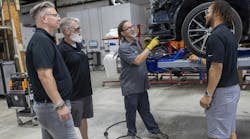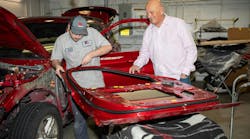Several collision repair industry organizations made a much-anticipated declaration last fall recognizing published OEM-based repair procedures as the standard—groups including the Society of Collision Repair Specialists (SCRS), Automotive Service Association (ASA), Alliance of Automotive Service Providers (AASP) and Assured Performance Network (APN). Since then, dozens of additional industry organizations, both national and international, have expressed support.
“The industry has already been clear. OEM-published repair procedures are our standard of repair,” says Aaron Schulenburg, executive director of the SCRS.
The problem, however, is that many shops don’t always know how to follow them. Douglas Craig, collision repair manager for Chrysler, says some repair centers are not Internet savvy, and not attuned to finding repair information online. All auto manufacturers have the information on their websites, but it can be hidden and tough to locate, he says.
Craig notes there are websites such as OEM1Stop.com, where repairers can acquire information, but it’s still believed that the industry needs a simpler method. The next step is to compile information in a way that allows all repairers to easily and affordably obtain the documents, such as in technical bulletins, position statements, body repair manuals and guideline books.
A work group was developed to spearhead the initiative. The group, which has held several meetings since the initial November announcement, is composed of representatives from SCRS, ASA, AASP, APN, I-CAR, Honda, Toyota, Ford, General Motors, Chrysler and the OEM Roundtable.
The goal is to compile published OEM technical repair information from all auto manufacturers and put it in one centralized location. The point is to give all collision repairers easy and free access to the repair information, and to devise a process that allows the industry to point out areas of deficiency in OEM
repair procedures.
Craig, who is a work group member, outlines a process that’s in motion to move the effort forward. First, the work group agreed that auto manufacturers should create and write the repair logic and standard methods. Craig says OEMs don’t have all of their documentation developed quite yet, but he’s in the process of creating several new technical repair bulletins on behalf of Chrysler.
The second step was to identify a location for housing the information. The work group submitted a request to I-CAR, which the training organization approved in July. I-CAR said it expects to have infrastructure in place to support and facilitate access to OEM repair procedures by July 2013.
The third step is for every auto manufacturer to stock the database with information and keep it updated. Craig says he’s compiling a list of key contacts at each car company
for assistance.
One issue to resolve is how much information each company is willing to make available without charge. Craig says every auto manufacturer has a different stance on this issue.
Scott Biggs, CEO of the Assured Performance Network, says there are some naysayers in the industry who oppose the idea. Disagreement isn’t over the development of OEM-based repair standards, but rather how the effort is carried out and presented to the industry.
For example, members of a Collision Industry Conference (CIC) committee believe an independent entity should be established to facilitate and maintain the initiative—instead of using an organization such as I-CAR.
Biggs argues the process set in motion by the work group makes the most sense.
“OEMs already put this information out. I-CAR already coordinates with them and offers feedback. Associations already offer formal and informal feedback to OEMs when they encounter something,” Biggs says. “We’re just formalizing a process out of what already exists to do it better and more efficiently.”



